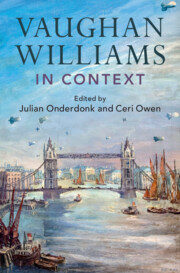Book contents
- Vaughan Williams in Context
- Composers in Context
- Vaughan Williams in Context
- Copyright page
- Dedication
- Contents
- Illustrations
- Graphs and Tables
- Musical Examples
- Notes on Contributors
- Acknowledgements
- Editorial Note
- Bibliographic Abbreviations
- Introduction
- Part I Biography, People, Places
- Part II Inspiration and Expression
- Part III Culture and Society
- Part IV Arts
- Part V Institutions
- Part VI Reception
- Chapter 29 Reception Outside England, 1901–1914
- Chapter 30 Interwar Continental Reception
- Chapter 31 Early Recordings
- Chapter 32 Reception in the USA:
- Further Reading
- Index of Works
- General Index
Chapter 32 - Reception in the USA:
A Special Relationship
from Part VI - Reception
Published online by Cambridge University Press: 28 March 2024
- Vaughan Williams in Context
- Composers in Context
- Vaughan Williams in Context
- Copyright page
- Dedication
- Contents
- Illustrations
- Graphs and Tables
- Musical Examples
- Notes on Contributors
- Acknowledgements
- Editorial Note
- Bibliographic Abbreviations
- Introduction
- Part I Biography, People, Places
- Part II Inspiration and Expression
- Part III Culture and Society
- Part IV Arts
- Part V Institutions
- Part VI Reception
- Chapter 29 Reception Outside England, 1901–1914
- Chapter 30 Interwar Continental Reception
- Chapter 31 Early Recordings
- Chapter 32 Reception in the USA:
- Further Reading
- Index of Works
- General Index
Summary
No country outside Britain has embraced Vaughan Williams’s music more warmly and extensively than the USA. The composer first visited in 1922 (extended stays followed in 1932 and 1954), but he had earlier developed a sympathy for American democratic ideals through intense involvement with Walt Whitman’s poetry. Vaughan Williams’s stature in America grew steadily from around 1920, when major works, most notably A London Symphony, began to be performed regularly, and it reached a zenith in the 1940s and 1950s, when he was widely regarded as a major international figure in the same league as Stravinsky or Bartók. While his American reputation echoed the deepening Anglo-American ‘special relationship’ that developed during the alliances of the Second World War and the Cold War, advocacy from a wide range of European émigrés such as Serge Koussevitzky and Bruno Walter indicates a broad appeal reaching well beyond any narrow notion of Anglo-Saxon kinship. Vaughan Williams’s profound engagement with folk song, modality, Whitman, and the symphony aligned particularly closely with prevailing trends in American music c. 1930–60, and his impact can be felt in the work of composers like Samuel Barber and Roy Harris; more recently, the admiration of John Adams, among others, indicates continuing relevance.
- Type
- Chapter
- Information
- Vaughan Williams in Context , pp. 276 - 282Publisher: Cambridge University PressPrint publication year: 2024

